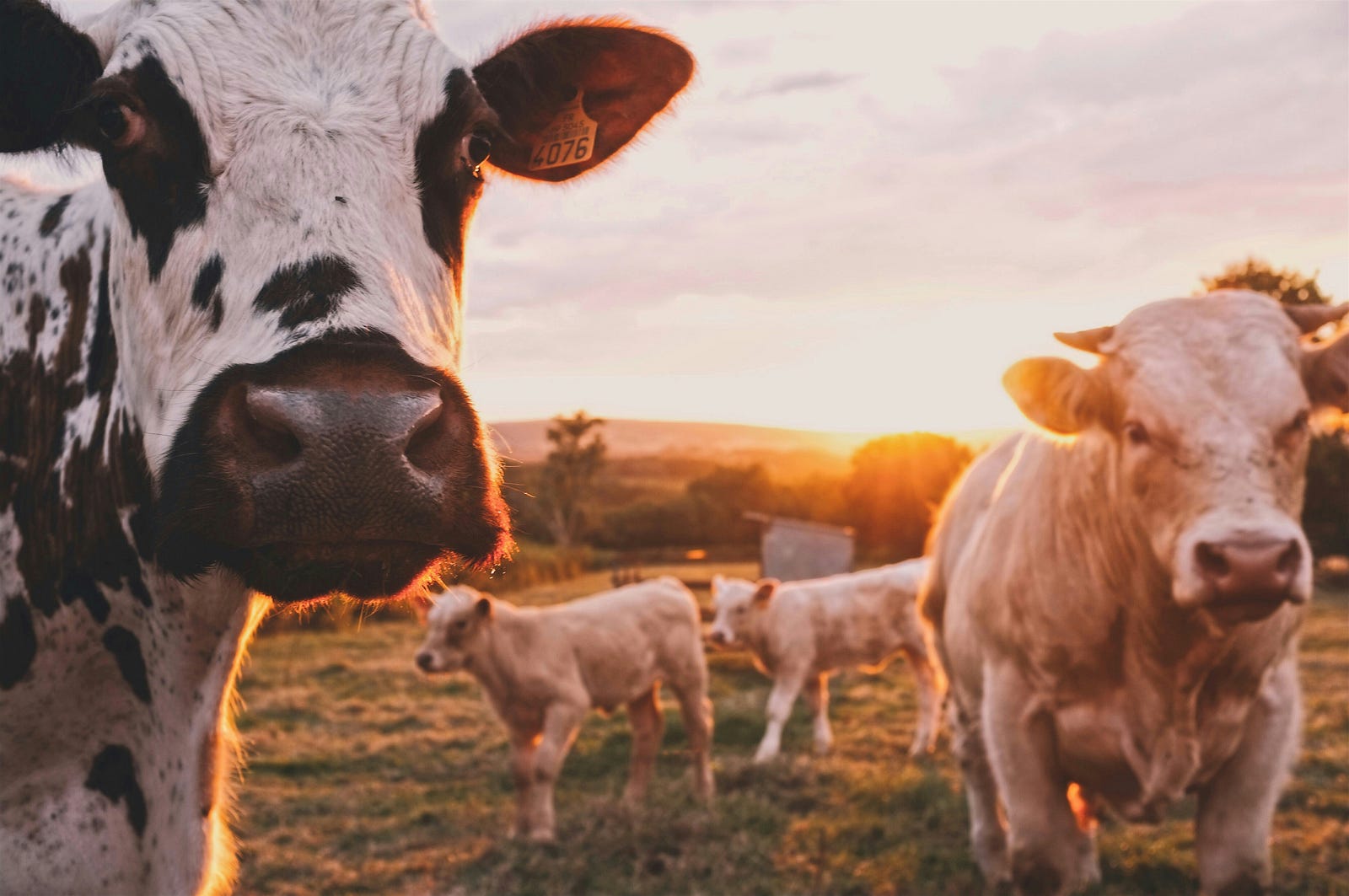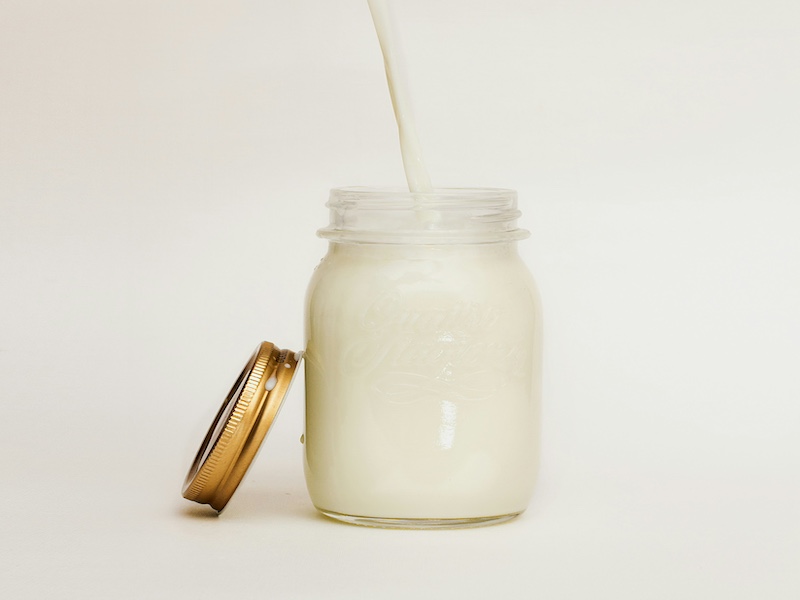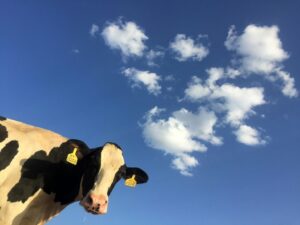The surprising history of why we drink cow milk illustrates how problematic culture is when it comes to overcoming the climate crisis.
Milk, glorious, milk…whether it’s cheese, yoghurt, ice cream or a refreshing glass of milk, we can’t seem to get enough of the white stuff. Over 850 million tonnes of dairy is produced annually to meet demand for all things dairy. That’s a lot of milk. Enough for every person in the world to fill a bathtub full of milk (and bath in it, if that’s your thing), and they would still have plenty left over for a cup of tea.
Since the day you were born, people have eaten lots of food made from dairy. It’s so normal to do so you’re more likely to be questioned for not consuming dairy because it’s embedded within cultures.
In The Evolution of Culture, the anthropologist Leslie White defines culture as “a rule system that…governs behaviour.” Cultures consist of “tools, implements, utensils, clothing, ornaments, customs, institutions, beliefs, rituals, games, works of art, language, etc.” Combine these various elements and cultures create an agreed way of doing things that unites individuals into a group of people with a shared understanding of the lived environment.
The norms, values and traditions that make up culture don’t just appear out of thin air. They are a product of an evolutionary process, where the adoption of certain behaviours is often circumstantial. It makes sense within the confines of the situation that triggered a change. The history of why we consume dairy is an example of this process.
As Marvin Harris points out in Our Kind, “all the major steps in cultural evolution took place in the absence of anyone’s conscious understanding of what was happening.” The result is a “cornucopia of unintended, undesirable, and unanticipated consequences.”
Dairy production is a case in point. To produce 850 million tonnes of milk, you need a lot of cows. Over 1.5 billion, as it happens. Those cows burp a prodigious amount. When they do, they release methane (a greenhouse gas) into the atmosphere. Methane makes up 52 percent of all greenhouse gas emissions from the dairy industry, which in turn contributes four percent of total greenhouse gas emissions worldwide.

The unintended consequence of industrial scale milk production is that it contributes to increasing concentrations of greenhouse gases in the atmosphere, which leads to global warming that has induced a climate crisis.
Clearly in producing dairy, no one wants to contribute to climate change. That’s why culture and the process of cultural change is so problematic when it comes to overcoming the climate crisis. A short history of why we drink cow milk is useful in illustrating the point.
A brief history of cow milk
The earliest evidence of humans using cattle for milk is 6,000 years ago in the ancient civilisations of Mesopotamia and Egypt. Consuming milk from cows became common practice in Europe, North Africa and inner Asia.
As the geographer Frederick J. Simoons argues in a paper on the history of dairy, as late as 500 years ago, “there remained vast areas of Eurasia and Africa in which people possessed cattle or other herd animals suitable for milking but failed to milk them.” In another paper, Simoons argues, they chose not to drink milk due to beliefs that “such milk is not proper food for man: that it is an animal secretion; that it smells and tastes bad; that it is unclean.”
Another factor is that lots of people are allergic to lactose. Lactose is the sugar in milk. To get the nutritional value from lactose, it needs to be broken down by the enzyme lactase that lives in our intestines and bowels. If we’re unable to break down the lactose, it travels to the large intestine, where it ferments, producing gas, carbon dioxide and lactic acid.
Lactose intolerance, as it’s commonly known, results in bloating, cramps, diarrhoea and flatulence. That consuming milk can lead to undesired symptoms makes it all the more unlikely it was destined to become such a dominant food.
Frederick Simoons has proposed a theory that our ability to consume dairy products evolved over a long period of time. In pastoral economies, when people were faced with the prospect of starvation, they would consume milk.
Those who were not lactose intolerant, or had mild symptoms when drinking milk, had a selective advantage over those who had severe symptoms. They were able to get the benefits of the protein and nutrient-rich milk without suffering side effects.
As Simoons argues, “the absorber would be able to consume more milk without symptoms and perhaps better be able to utilise its nutrients. He would thus be more fit, and his genotype would in time come to prevail among his group.”
Evidence supporting his genetic hypothesis is that today, in all of the areas where milk drinking did not become part of the culture, there is a much higher prevalence of lactose intolerance than in those where milk drinking did become part of the culture. This suggests that people in the milk-drinking regions developed a genetic tolerance to milk over time that the non-drinking regions did not.
The fact a tradition of milk drinking formed not by choice but by necessity is an example of how, since the dawn of human history, life has revolved around a struggle to get enough food to eat.
A prime necessity?
That’s why milk was such a vital source of nutrition. Up until recently, milk, rich in calcium and protein, has been seen as indispensable in providing nutrients to hungry children.
The classic Milky Bar Kid adverts which became a famous marketing campaign in the 1960s, and still runs to this day, reflects opinion on the health benefits of milk. The famous jingle accompanying the advert goes a little like this:
“The milky bar kid is strong and tough,
the creamiest milk,
the whitest bar,
the goodness that’s in Milky Bar.”
The Milky Bar Kid would sign off with his famous catchphrase, “The Milky Bars are on me!” The messaging is clear; the goodness in the Milky Bar will make you strong. While the lyrics of the song have now been adapted to say “the good taste that’s in Milky Bar”, the idea that milk is good for us has enshrined it as a healthy food.
The UK’s National Health Service continues to feature a ‘Milk and dairy foods’ section on its ‘Eat well’ page. A reason why is that milk is high in calcium. It’s believed calcium helps give us strong bones, with plenty of studies showing how a diet rich in dairy can help prevent osteoporosis — a bone disease that leads to weak bones that break easily.
Due to these studies, it’s recommended to have a diet rich in calcium, and the dairy industry is all too keen to support this argument. The link between calcium intake and bone strength is highly controversial. There are plenty of other studies showing a diet high in calcium increases the risk of osteoporosis and various cardiovascular diseases.
This would help explain why in America, one of the biggest consumers of milk worldwide, women over the age of fifty have the highest rate of hip fractures in the world. The milk industry, which has much to lose if milk loses its reputation as the healthiest of foods, understandably doesn’t agree, and still markets milk as being good for your bones due to its high calcium content.
It has led to a back and forth, like a struggle of wills between two tennis players, where the milk industry claims milk is great for us, and keeps our bones strong, while various academics argue the exact opposite. It leaves people having no idea who or what to believe.
As the biochemist Colin Campbell puts it in The China Study; “the confusion, conflict and controversy rampant in this area of research allow anybody to say just about anything. And of course, huge amounts of money are at stake as well.”
That so much money is at stake is perhaps the most important aspect of all this. The dairy industry began life as a necessity to ward off starvation. It then developed into a tradition and became embedded into culture based on it being an essential source of nutrients. Now, it has become a multi-billion dollar industry.

It makes no difference if milk is good for us or not, what matters is that the belief helps sustain the industry and leads people to continue consuming dairy in massive quantities. It has to be said that people don’t just consume milk for its health benefits, cheese and ice cream aren’t so good for us, but they taste pretty darn good.
In a similar way to eating meat, eating dairy is associated with affluence. China has experienced enormous increases in prosperity accompanied by a growing middle class over the last few decades. Increasing incomes have seen demand for dairy soaring, to the extent that China has become one of the biggest consumers of milk worldwide.
A growing global middle class is leading to shifting dietary habits, which helps explain why the global demand for dairy products continues to increase.
Aside from the controversy surrounding its health benefits, if dairy production plays such a significant role in global warming, and if we no longer depend on it for sustenance, then the solution seems almost embarrassingly obvious — we should all stop eating dairy.
Insurmontable barriers
Here is where tradition plays such a vital role in behaviour. Traditions become cemented into culture — to the point where the culture is an unquestioned way of doing things. So we can’t just simply wipe the slate clean, hope everyone forgets they ever ate dairy, and structure society appropriately for the time we live in.
After thousands of years of consuming milk, our lives are intertwined with the tradition continuing, while the economy of the milk industry that was born out of the tradition depends on it continuing.
The vested interests that have formed because of the tradition are the most important aspect of all this. Regardless of the damage to the environment and the fact our health may well be better off without it, those powerful vested interests have everything to lose if the culture of eating dairy is lost.
There are plenty of people who have embraced a plant-based diet due to the environmental impacts of producing meat and dairy. There are plenty of others who argue a great social transformation is required to overcome the climate crisis. These calls get lost in the wind.
The changes we must make to create sustainable societies would involve questioning culture. Questioning our very reality. It would involve making sacrifices to living standards the majority would simply be unwilling to make.
This is why the climate crisis is such a wicked problem. A fundamental issue is that the products we buy on an individual level are detached from the billions of other products billions of other people buy. When combined, it’s billions of self-serving decisions that lead to environmental change on a global level.
What makes it worse is that you can’t blame individuals for behaving as they do. These decisions are so often driven by cultural context. The idea we should question elements of culture seems alien and extreme when culture forms the foundations of our reality.
No one said overcoming the most difficult challenge humanity has ever faced would be easy. And given the barriers to transformation, it appears that the will to change isn’t, unfortunately, going to arise from some global epiphany. We’ll change when we’re forced to change. When we are overwhelmed by weather extremes that are set to inundate us with wave after wave of crisis. It’s only then that people will start to question their reality. By that point, it may be too late.



